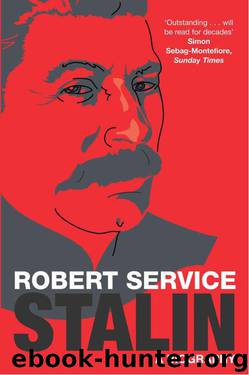Stalin: A Biography by Robert Service

Author:Robert Service [Service, Robert]
Language: eng
Format: epub
Tags: Biography & Autobiography, Political, History, Historical, Europe, Presidents & Heads of State, Russia & the Former Soviet Union
ISBN: 9780674022584
Google: hSWK6Dh4wRgC
Amazon: 0674022580
Publisher: Harvard University Press
Published: 2005-06-15T02:09:47+00:00
32. THE CULT OF IMPERSONALITY
The Lenin cult glistened like a film of oil over the dark ocean of Soviet reality in the late 1930s. Stalin had always presided over its rites. It had been he who arranged for the corpse of the Soviet leader to be displayed in the Mausoleum. He organised the publication of Lenin’s memoirs and helped to set up an Institute of Lenin. He vowed undying allegiance to Lenin’s ideas and practices. During the New Economic Policy he claimed to be a mere pupil of the great man.
The ‘biography’ by Lenin’s aide Ivan Tovstukha in 1927 was really just a catalogue of his arrests, places of exile, main publications and official posts. Although it mentioned Stalin’s support for Lenin against Kamenev and Zinoviev in October 1917, there was no reference to subsequent factional campaigns, and he was listed as being merely ‘one of the secretaries of the Party Central Committee from 1922’: his full title of General Secretary was omitted.1 With Stalin’s rise to political supremacy at the end of the 1920s all this started to change. After sending Bukharin and the Right Deviation down to defeat, he demanded appreciation as more than a party administrator. On 21 December 1929 Stalin’s (supposed) fiftieth birthday was celebrated with the fanfares of a ceremony of state.2 Even if he had been bashful (and in fact he was wary of making himself look ridiculous by permitting excessive praise),3 political self-interest dictated the need for media acclaim in a period when oppositionist leaders were making scathing criticisms. Stalin aspired to his own personal cult.
He continued to express admiration for his predecessor. Although he allowed others to use the term ‘Marxism–Leninism–Stalinism’, he himself avoided it. Stalin even refused to sanction a complete edition of his collected works (whereas Trotski had already published twenty-one volumes of his writings before falling from grace). Addressing a large Moscow conference on propaganda in 1938, he condemned attempts to put him on the same level as Lenin as a party theorist. His Foundations of Leninism, Stalin insisted, was only a work of exegesis. The originality of thought lay with Lenin, which was why it made sense to talk of Marxism–Leninism and not just Marxism. But the teacher ought not to be confused with the pupil.4
Nevertheless he often allowed his light to outshine the aureole surrounding his predecessor. Comparisons of the two men began to be made at Lenin’s expense. The party historian Yemelyan Yaroslavski opined that Stalin was the more decisive of the two leaders and that the reason lay in the excessive number of years spent by Lenin in emigration.5 But usually the downgrading of Lenin was done in a visual fashion rather than in texts. On New Year’s Day in 1931 Pravda carried a line drawing of Stalin on its front page – and Lenin appeared in it only as a name printed on a banner.6 A similar picture was used to emphasise Stalin’s greatness in the annals of Soviet communism on New Year’s Day in 1937.
Download
This site does not store any files on its server. We only index and link to content provided by other sites. Please contact the content providers to delete copyright contents if any and email us, we'll remove relevant links or contents immediately.
| Military | Political |
| Presidents & Heads of State | Religious |
| Rich & Famous | Royalty |
| Social Activists |
Waking Up in Heaven: A True Story of Brokenness, Heaven, and Life Again by McVea Crystal & Tresniowski Alex(37027)
Empire of the Sikhs by Patwant Singh(22194)
We're Going to Need More Wine by Gabrielle Union(18095)
Hans Sturm: A Soldier's Odyssey on the Eastern Front by Gordon Williamson(16913)
Leonardo da Vinci by Walter Isaacson(11933)
The Radium Girls by Kate Moore(10933)
Educated by Tara Westover(7090)
Tools of Titans by Timothy Ferriss(6983)
How to Be a Bawse: A Guide to Conquering Life by Lilly Singh(6712)
The Last Black Unicorn by Tiffany Haddish(5087)
Permanent Record by Edward Snowden(5017)
The Rise and Fall of Senator Joe McCarthy by James Cross Giblin(4854)
Promise Me, Dad by Joe Biden(4463)
The Wind in My Hair by Masih Alinejad(4434)
The Crown by Robert Lacey(4122)
A Higher Loyalty: Truth, Lies, and Leadership by James Comey(4046)
The Iron Duke by The Iron Duke(3659)
Joan of Arc by Mary Gordon(3275)
How to be Champion: My Autobiography by Sarah Millican(3198)
